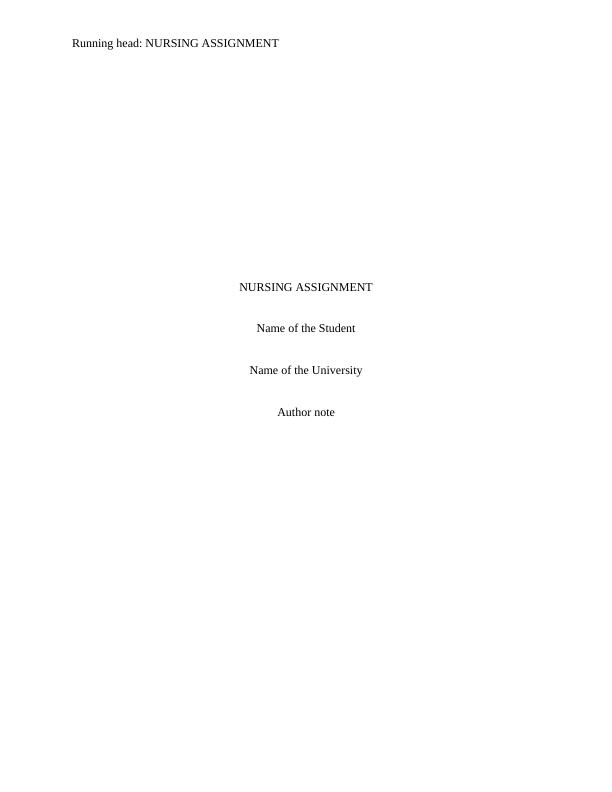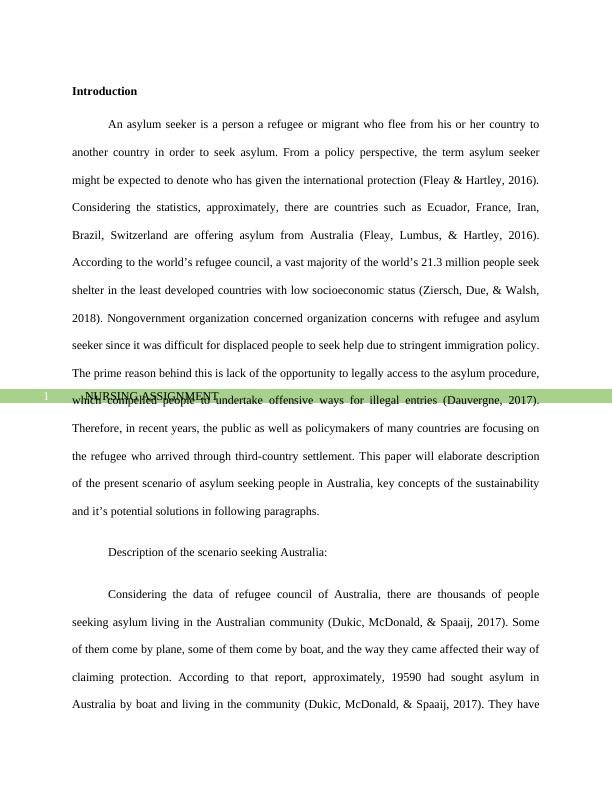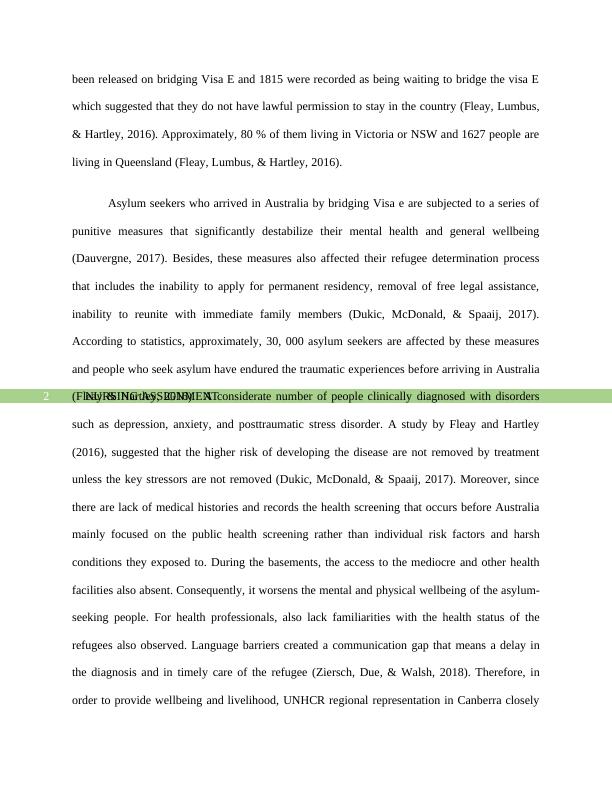Australia and Asylum Seekers
Added on 2021-09-14
9 Pages2184 Words47 Views
Running head: NURSING ASSIGNMENT
NURSING ASSIGNMENT
Name of the Student
Name of the University
Author note
NURSING ASSIGNMENT
Name of the Student
Name of the University
Author note

NURSING ASSIGNMENT 1
Introduction
An asylum seeker is a person a refugee or migrant who flee from his or her country to
another country in order to seek asylum. From a policy perspective, the term asylum seeker
might be expected to denote who has given the international protection (Fleay & Hartley, 2016).
Considering the statistics, approximately, there are countries such as Ecuador, France, Iran,
Brazil, Switzerland are offering asylum from Australia (Fleay, Lumbus, & Hartley, 2016).
According to the world’s refugee council, a vast majority of the world’s 21.3 million people seek
shelter in the least developed countries with low socioeconomic status (Ziersch, Due, & Walsh,
2018). Nongovernment organization concerned organization concerns with refugee and asylum
seeker since it was difficult for displaced people to seek help due to stringent immigration policy.
The prime reason behind this is lack of the opportunity to legally access to the asylum procedure,
which compelled people to undertake offensive ways for illegal entries (Dauvergne, 2017).
Therefore, in recent years, the public as well as policymakers of many countries are focusing on
the refugee who arrived through third-country settlement. This paper will elaborate description
of the present scenario of asylum seeking people in Australia, key concepts of the sustainability
and it’s potential solutions in following paragraphs.
Description of the scenario seeking Australia:
Considering the data of refugee council of Australia, there are thousands of people
seeking asylum living in the Australian community (Dukic, McDonald, & Spaaij, 2017). Some
of them come by plane, some of them come by boat, and the way they came affected their way of
claiming protection. According to that report, approximately, 19590 had sought asylum in
Australia by boat and living in the community (Dukic, McDonald, & Spaaij, 2017). They have
Introduction
An asylum seeker is a person a refugee or migrant who flee from his or her country to
another country in order to seek asylum. From a policy perspective, the term asylum seeker
might be expected to denote who has given the international protection (Fleay & Hartley, 2016).
Considering the statistics, approximately, there are countries such as Ecuador, France, Iran,
Brazil, Switzerland are offering asylum from Australia (Fleay, Lumbus, & Hartley, 2016).
According to the world’s refugee council, a vast majority of the world’s 21.3 million people seek
shelter in the least developed countries with low socioeconomic status (Ziersch, Due, & Walsh,
2018). Nongovernment organization concerned organization concerns with refugee and asylum
seeker since it was difficult for displaced people to seek help due to stringent immigration policy.
The prime reason behind this is lack of the opportunity to legally access to the asylum procedure,
which compelled people to undertake offensive ways for illegal entries (Dauvergne, 2017).
Therefore, in recent years, the public as well as policymakers of many countries are focusing on
the refugee who arrived through third-country settlement. This paper will elaborate description
of the present scenario of asylum seeking people in Australia, key concepts of the sustainability
and it’s potential solutions in following paragraphs.
Description of the scenario seeking Australia:
Considering the data of refugee council of Australia, there are thousands of people
seeking asylum living in the Australian community (Dukic, McDonald, & Spaaij, 2017). Some
of them come by plane, some of them come by boat, and the way they came affected their way of
claiming protection. According to that report, approximately, 19590 had sought asylum in
Australia by boat and living in the community (Dukic, McDonald, & Spaaij, 2017). They have

NURSING ASSIGNMENT 2
been released on bridging Visa E and 1815 were recorded as being waiting to bridge the visa E
which suggested that they do not have lawful permission to stay in the country (Fleay, Lumbus,
& Hartley, 2016). Approximately, 80 % of them living in Victoria or NSW and 1627 people are
living in Queensland (Fleay, Lumbus, & Hartley, 2016).
Asylum seekers who arrived in Australia by bridging Visa e are subjected to a series of
punitive measures that significantly destabilize their mental health and general wellbeing
(Dauvergne, 2017). Besides, these measures also affected their refugee determination process
that includes the inability to apply for permanent residency, removal of free legal assistance,
inability to reunite with immediate family members (Dukic, McDonald, & Spaaij, 2017).
According to statistics, approximately, 30, 000 asylum seekers are affected by these measures
and people who seek asylum have endured the traumatic experiences before arriving in Australia
(Fleay & Hartley, 2016). A considerate number of people clinically diagnosed with disorders
such as depression, anxiety, and posttraumatic stress disorder. A study by Fleay and Hartley
(2016), suggested that the higher risk of developing the disease are not removed by treatment
unless the key stressors are not removed (Dukic, McDonald, & Spaaij, 2017). Moreover, since
there are lack of medical histories and records the health screening that occurs before Australia
mainly focused on the public health screening rather than individual risk factors and harsh
conditions they exposed to. During the basements, the access to the mediocre and other health
facilities also absent. Consequently, it worsens the mental and physical wellbeing of the asylum-
seeking people. For health professionals, also lack familiarities with the health status of the
refugees also observed. Language barriers created a communication gap that means a delay in
the diagnosis and in timely care of the refugee (Ziersch, Due, & Walsh, 2018). Therefore, in
order to provide wellbeing and livelihood, UNHCR regional representation in Canberra closely
been released on bridging Visa E and 1815 were recorded as being waiting to bridge the visa E
which suggested that they do not have lawful permission to stay in the country (Fleay, Lumbus,
& Hartley, 2016). Approximately, 80 % of them living in Victoria or NSW and 1627 people are
living in Queensland (Fleay, Lumbus, & Hartley, 2016).
Asylum seekers who arrived in Australia by bridging Visa e are subjected to a series of
punitive measures that significantly destabilize their mental health and general wellbeing
(Dauvergne, 2017). Besides, these measures also affected their refugee determination process
that includes the inability to apply for permanent residency, removal of free legal assistance,
inability to reunite with immediate family members (Dukic, McDonald, & Spaaij, 2017).
According to statistics, approximately, 30, 000 asylum seekers are affected by these measures
and people who seek asylum have endured the traumatic experiences before arriving in Australia
(Fleay & Hartley, 2016). A considerate number of people clinically diagnosed with disorders
such as depression, anxiety, and posttraumatic stress disorder. A study by Fleay and Hartley
(2016), suggested that the higher risk of developing the disease are not removed by treatment
unless the key stressors are not removed (Dukic, McDonald, & Spaaij, 2017). Moreover, since
there are lack of medical histories and records the health screening that occurs before Australia
mainly focused on the public health screening rather than individual risk factors and harsh
conditions they exposed to. During the basements, the access to the mediocre and other health
facilities also absent. Consequently, it worsens the mental and physical wellbeing of the asylum-
seeking people. For health professionals, also lack familiarities with the health status of the
refugees also observed. Language barriers created a communication gap that means a delay in
the diagnosis and in timely care of the refugee (Ziersch, Due, & Walsh, 2018). Therefore, in
order to provide wellbeing and livelihood, UNHCR regional representation in Canberra closely

End of preview
Want to access all the pages? Upload your documents or become a member.
Related Documents
Australia’s Mandatory Detention Policy Reportlg...
|7
|2165
|372
Issues Related to Australian Policy Regarding the Detention on Manus and Nauru Islandslg...
|6
|1845
|222
Sustainable Development for Health and Livelihood of Asylum Seekers in Australialg...
|9
|2515
|387
Asylum Seekers and Refugees in Australialg...
|14
|4449
|69
Exploring Sustainability: The Health and Livelihoods of Asylum Seekerslg...
|9
|2046
|49
Proposal for Amendment in Immigration Health Policieslg...
|8
|2334
|48
